How to Prepare Clay Pot for the First Use
Unglazed clay pots require some preparation before they are ready to use. To prepare the clay pot for cooking for the first time, immerse it in a clean bucket of water for at least an hour. You can also leave it in a sink completely covered with water overnight. Remove the pot from the water and allow it to dry thoroughly.
How to Season a Clay Pot
Wipe any unglazed areas of the pot and rub with olive or vegetable oil. Fill the pot 3/4 full with water. Put the lid on. Place the oiled pot in a cold oven. Turn the heat on to 350 degrees Fahrenheit. Let it bake for 2 to 3 hours. Turn off the stove and allow the pot to cool completely. Then wash the pot and store it in a cool, dry place. Seasoning increases the hardness and durability of clay cookware, making it more resistant to cracking and eliminating the initial clay smell.
How to Cook in Clay Pots
Unglazed clay cooking pots can be used in the oven or microwave. Some clay pots are intended for cooking or grilling on the stove and are labeled accordingly. Be sure to read and follow the manufacturer’s instructions for using and maintaining your stoneware. When using unglazed clay cookware, certain rules must be followed.
- Before cooking
Unglazed clay pot and lid must be completely submerged in water for at least 15 minutes before preparing a meal. Because the pot is porous, it absorbs moisture when soaking. As the pot is slowly heated, the clay slowly releases steam from its pores, gently cooking the food. This prevents the food from drying out. Natural juices and flavors are retained in the pot while maintaining nutritional content.
Appropriate Temperature Settings: A sudden rise or fall in temperature can cause a clay pot to burst. Always place your clay cookware in the middle of a cold oven and let the oven gradually heat up. The pot should not touch the sides of the oven. When cooking with clay, the heat should be set to medium or lower. Start with low heat and slowly increase the temperature for about 5 minutes.
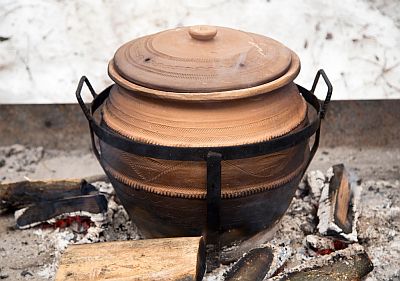
2. During cooking
Do not exceed the recommended cooking temperature: According to the recipe, the recommended oven temperature is between 190 °C and 250 °C. Because wet clay doesn’t get as hot as metal baking pans, you’ll want to bake it about 20 minutes longer to make up for the time needed to heat the oven. When cooking in clay pots, the oven temperature must be set at an average of 40°C higher than normal. If food takes longer to cook, use a lower heat. If you want the food to brown and crisp, remove the lid during the last 10 to 20 minutes of cooking.
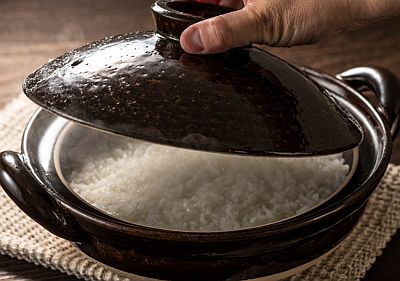
Avoid adding cold water: Never add cold ingredients or cold water to an already heated clay pot as this may cause the pot to crack. If more liquid needs to be added to the pot during cooking, pour in only hot liquid.
3. After cooking
Be sure to use oven gloves or baking pads when removing a stoneware cooking pot from the oven. After removal from the oven, place the pot on a heatproof trivet or wooden board. Placing a hot pot on a cold countertop may cause the clay to crack. Lift the lid carefully to avoid scalding yourself from the rising steam.
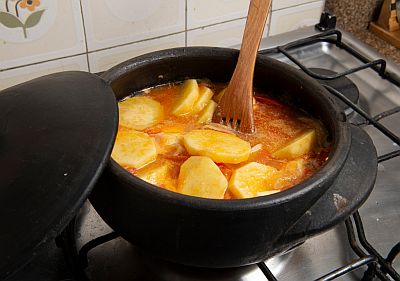
How to Clean Clay Cookware
While some say it’s okay to put a clay pot in the dishwasher, hand washing is recommended. Extreme temperatures and harsh cleaning products can strip spices and damage clay cookware.
After removing the clay pot from the oven, allow it to cool completely and then soak it in warm water for a few minutes to loosen any leftover food. To remove food residue, use hot water without detergent and a gentle scrubbing pad. To neutralize strong odors, fill the pot with warm water and add two tablespoons of baking soda. Allow the cookware to soak for at least 15 minutes.
For general and thorough cleaning, soak the clay pot in water mixed with baking soda in the sink overnight. Add 3 tablespoons of baking soda per liter of hot water. Wash the pot with a soft brush or a non-metallic scouring pad. Do not use abrasive scouring powders as they will clog the pores and make the pot unusable. Salt can be used as a non-toxic alternative to chemical cleaners. Sprinkle salt into the pot and clean it with a scouring pad. Rinse the pot with warm water and let it dry.
If mold forms during storage, sprinkle baking soda into the pot and then rinse with warm water and a brush to remove the mold. If the clay pores become clogged, the pot should be boiled in hot water for about 30 minutes.
Never use soap or detergent as the porous nature of the clay will absorb the soap. The dishwashing liquid may leave an unpleasant soapy taste that will spread again the next time you eat a clay pot meal.
Over time, your clay pot may darken slightly and show burn marks and stains. This does not affect the cooking properties.
How to Store Clay Pots
After washing, make sure the pot is completely dry before storing it. Store the clay pot without a lid to allow air to circulate. Another option is to turn the lid over and place a paper towel between the pot and the lid to prevent splintering. Make sure you store your stoneware in dry and well-ventilated places. This eliminates the risk of mold formation.
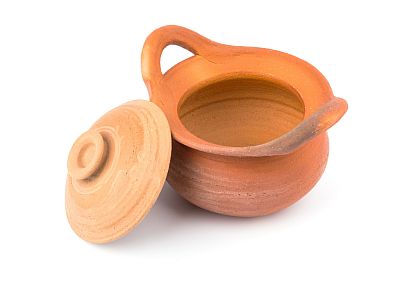
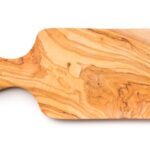


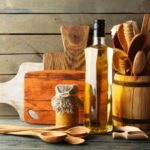
Nice article. I have been using pure-clay pots for cooking and I can see how they are way healthier than others. An important thing to keep in mind while buying a clay pot is to be sure that it’s free from chemical glazes and enamels. They leach into food while cooking and contaminate it. I purchased mine from Miriams Earthen Cookware in US as they seem to have researched a lot before choosing primary clay for making cookware and they do not use any chemicals. I have tested them using alkaline baking soda test [ https://miriamsearthencookware.com/2015/08/11/the-baking-soda-test-a-simple-reliable-method-to-test-cookwares-toxicity-in-your-kitchen/ ] and I am now sure that they are 100% non-toxic. Just thought I should share this important information with everybody.
Hi Sharon, I just got mine from MEC too I use them for 2 times and one of them got mold inside
what you advice me to do, so expensive I can t throw it
Good info.
I bought a new water clay pot they asked us to fill the pot with water and keep it under the sun , it was leaking water.. guess it was from the pores… but tgen we kept it for the next day too it was same and now its the fourth day, it still leaks out..!! How to stop it?? Or is it normal.. plss do answer me…
Unglazed clay is porous and absorbs some of the water that is poured into it, so it is normal for the clay pot to be moist outside. This moisture is evaporated due external temperature, providing the cooling effect on the water stored inside the pot. You may notice a slight leaking on the bottom of the pot, especially when it is new and the clay is not sealed enough from use.
If the leakage is consistent and prolonged, there might be a tiny crack that is not obvious. If the leakage is caused by cracks or a bad workmanship, you might want to contact the seller and ask for a replacement.
I found the above report very useful on How to Use and Maintain Clay Cookware. Recently, I bought several un-glazed clay pots, but they leak water seriously anytime I try to cook in them. How do I reduce or stop the water leakage?
This one-size-fits-all advice is exceedingly dangerous. How to prepare earthenware cookware varies with the cookware. For example, various potters emphatically advise not to soak low-fired cookware made from New Mexico mica clay. In the worst case, such a pot can explode; I have personally seen this happen. One should always follow the specific advice given by the maker of the pot, which varies considerably worldwide with the exact composition of the pot. The maker has a better idea than guessing.